Storm Drain
A storm drain, storm sewer (US), storm water drain (Australia and New Zealand) or drainage well system or simply a drain or drain system is designed to drain excess rain and ground water from paved streets, parking lots, sidewalks, and roofs. A storm drain can vary in design from small residential dry wells to large municipal systems. They are fed by street gutters on most motorways, freeways and other busy roads, as well as towns in areas which experience heavy rainfall, flooding and coastal towns which experience regular storms.
Storm Drain Inlet

There are two main types of storm drain (storm sewer) inlets; side inlets and grated inlets. Side inlets are located adjacent to the curb and rely on the ability of the opening under the back stone or lintel to capture flowinto the storm drain. They are usually depressed at the invert of the channel to improve capture capacity.Grated inlets have gratings or grids to prevent large objects and debris from falling into the storm drain sewer system. However, their bars are fairly widely spaced so that the flow of water is not impeded. Consequently, many small objects can fall through into the storm drain.
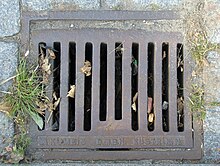
Many of these small objects are caught by the catch basin, or sump, which lies immediately below the grating. Water from the top of the catch basin drains into the sewer properly. The catch basin serves much the same function as the “trap” in household waste water plumbing in trapping objects.
In the United States, unlike the trap, the catch basin does not necessarily prevent sewer gases such as hydrogen sulfide and methane from escaping. However in the United Kingdom, where they are called gulley-pots, they are designed as true water-filled traps and do block the egress of gases and rodents coming from the storm drain.
Most catch basins will contain stagnant water during the drier parts of the year and can be used by mosquitoes for breeding. The performance of catch basins at removing sediment and other pollutants depends on the design of the catch basin (e.g., the size of the sump), and routine maintenance of a storm drain to retain the storage available in the sump to capture sediment. Municipalities typically have large vacuum trucks that perform this task.
Catch basins act as pretreatment for other treatment practices, such as retention basins, by capturing large sediments.

Storm Drain Piping
Storm drain pipes can come in many different shapes (rectangular, square, bread-loaf shaped, oval, inverted pear-shaped, and more commonly, circular). Storm drain systems may have many different features including waterfalls, stairways, balconies and pits for catching rubbish, sometimes called Gross Pollutant Traps (GPTs). Several different materials can also be used, such as brick, concrete, metal and even plastic in some cases.
Storm Drain Outlet
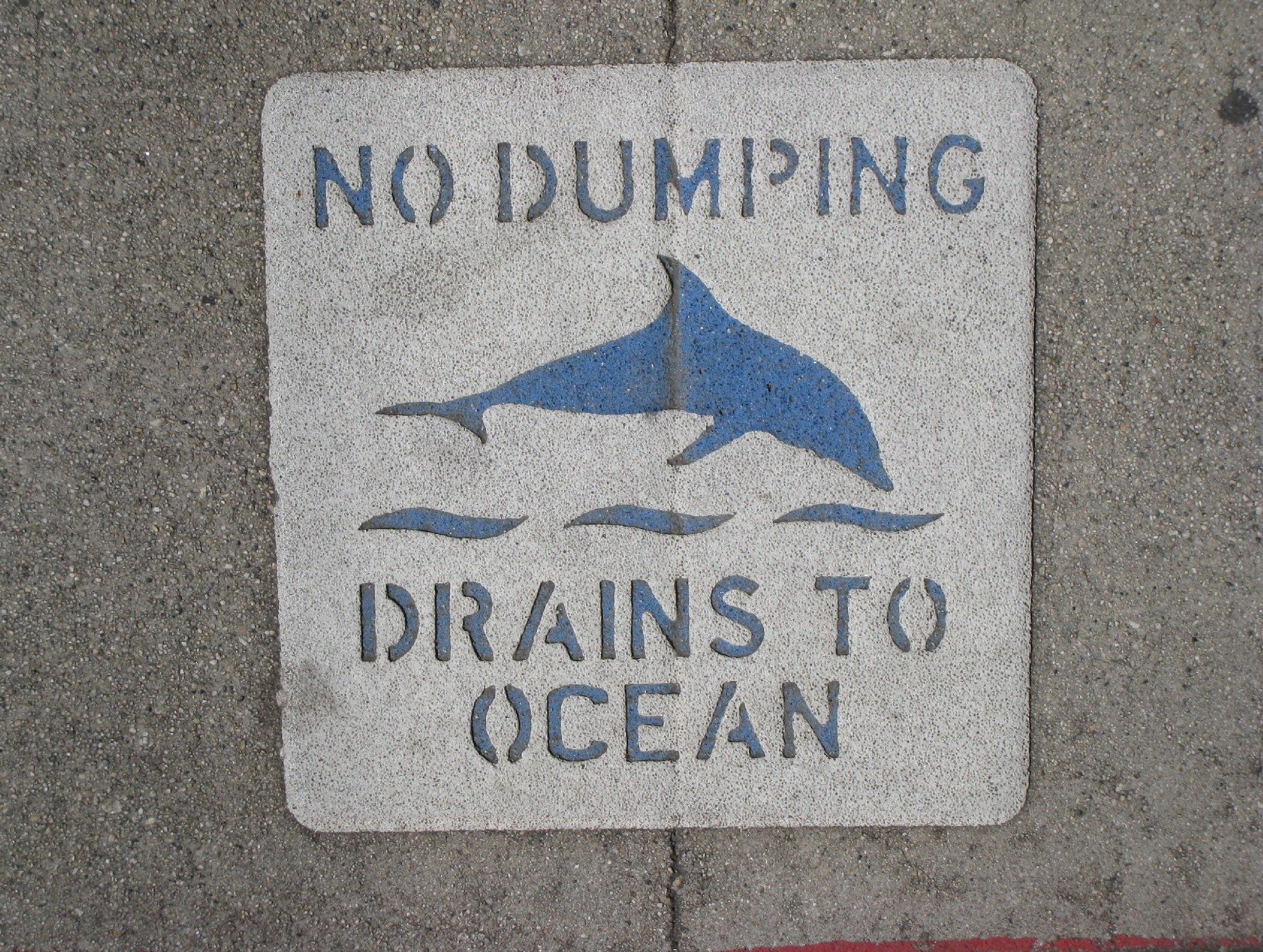 Most storm drains have a single large exit at their point of discharge (often covered by a grating) into a canal, river, lake, reservoir, sea or ocean. Other than catch basins, typically there are no treatment facilities in the piping system. A small storm drain may discharge into individual dry wells. A storm drain may be interconnected using slotted pipe, to make a larger dry well system. A storm drain may discharge into man-made excavations known as recharge basins or retention ponds.
Most storm drains have a single large exit at their point of discharge (often covered by a grating) into a canal, river, lake, reservoir, sea or ocean. Other than catch basins, typically there are no treatment facilities in the piping system. A small storm drain may discharge into individual dry wells. A storm drain may be interconnected using slotted pipe, to make a larger dry well system. A storm drain may discharge into man-made excavations known as recharge basins or retention ponds.
Environmental impacts
Storm Drain runoff effects our water quality
The first flush from urban runoff can be extremely dirty. Storm water may become contaminated while running down the road or other impervious surface, or from lawn chemical run-off, before entering the drain.
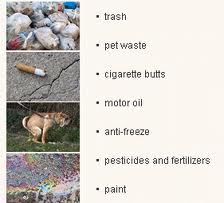 Water running off these impervious surfaces tends to pick up gasoline, motor oil, heavy metals, trash and other pollutants from roadways and parking lots, as well as fertilizers and pesticides from lawns. Roads and parking lots are major sources of nickel, copper, zinc, cadmium, lead and polycyclic aromatic hydrocarbons , which are created as combustion byproducts of gasoline and other fossil fuels. Roof runoff contributes high levels of synthetic organic compounds and zinc (from galvanized gutters). Fertilizer use on residential lawns, parks and golf courses is a significant source of nitrates and phosphorus.
Water running off these impervious surfaces tends to pick up gasoline, motor oil, heavy metals, trash and other pollutants from roadways and parking lots, as well as fertilizers and pesticides from lawns. Roads and parking lots are major sources of nickel, copper, zinc, cadmium, lead and polycyclic aromatic hydrocarbons , which are created as combustion byproducts of gasoline and other fossil fuels. Roof runoff contributes high levels of synthetic organic compounds and zinc (from galvanized gutters). Fertilizer use on residential lawns, parks and golf courses is a significant source of nitrates and phosphorus.
Separation of undesired runoff can be done by installing devices within the storm sewer system. These devices are new to the market and can only be installed with new development or during major upgrades. They are referred to as oil-grit separators (OGS) or oil-sediment separators (OSS). They consist of a specialized manhole chamber, and use the water flow and/or gravity to separate oil and grit.
Reducing storm drain water flow
Runoff into storm sewers can be minimized by including sustainable urban drainage systems (UK term) or low impact development practices (US term) into municipal plans. To reduce storm water from rooftops, flows from eaves troughs (rain gutters and downspouts) may be infiltrated into adjacent soil, rather than discharged into the storm sewer system.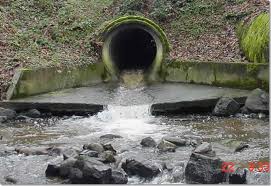 Storm water runoff from paved surfaces can be directed to unlined ditches (sometimes called swales or bioswales) before flowing into the storm sewers, again to allow the runoff to soak into the ground. Permeable paving materials can be used in building sidewalks, driveways and in some cases, parking lots, to infiltrate a portion of the storm water volume. In many areas detention tanks are required to be installed inside a property and are used to temporarily hold rainwater runoff during heavy rains and restrict the outlet flow to the public sewer. This lessens the risk of the public sewer being overburdened during a heavy rain. An overflow outlet may also be utilized which connects higher on the outlet side of the detention tank. This overflow would prevent the detention tank from completely filling up. By restricting the flow of water in this way and temporarily holding the water in a detention tank public sewers are far less likely to become surcharged.
Storm water runoff from paved surfaces can be directed to unlined ditches (sometimes called swales or bioswales) before flowing into the storm sewers, again to allow the runoff to soak into the ground. Permeable paving materials can be used in building sidewalks, driveways and in some cases, parking lots, to infiltrate a portion of the storm water volume. In many areas detention tanks are required to be installed inside a property and are used to temporarily hold rainwater runoff during heavy rains and restrict the outlet flow to the public sewer. This lessens the risk of the public sewer being overburdened during a heavy rain. An overflow outlet may also be utilized which connects higher on the outlet side of the detention tank. This overflow would prevent the detention tank from completely filling up. By restricting the flow of water in this way and temporarily holding the water in a detention tank public sewers are far less likely to become surcharged.
Storm drain in relation to sanitary sewer systems
A storm drain is separate and distinct from sanitary sewer systems. The separation of a storm drain from sanitary sewers helps to prevent sewage treatment plants becoming overwhelmed by infiltration/inflow during a rainstorm, which can result in untreated sewage being discharged into the environment.
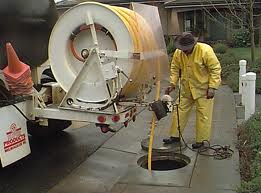 Many storm drain systems are designed to drain the storm water, untreated, into rivers or streams. Many local governments conduct public awareness campaigns about this, lest waste be dumped into the storm drain system.In the city of Cleveland, Ohio, for example, all new catch basins installed have inscriptions on them not to dump any waste, and usually include a fish imprint as well. Trout Unlimited Canada recommends that a yellow fish symbol be painted next to existing storm drains.
Many storm drain systems are designed to drain the storm water, untreated, into rivers or streams. Many local governments conduct public awareness campaigns about this, lest waste be dumped into the storm drain system.In the city of Cleveland, Ohio, for example, all new catch basins installed have inscriptions on them not to dump any waste, and usually include a fish imprint as well. Trout Unlimited Canada recommends that a yellow fish symbol be painted next to existing storm drains.
Call Option One Plumbing for all your Storm Drain Cleaning And Maintenance Needs in Scottsdale. 1-800-905-7115
1-800-905-7115


I feel that is among the so much important ioamrnftion for me. And i am glad studying your article. But wanna commentary on some basic things, The website style is great, the articles is really great : D. Good process, cheers